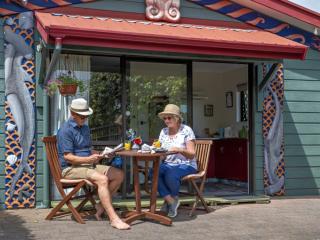Unique experience in a romantic hideaway at sunny Ohope Beach. We welcome you with complimentary drinks and nibbles.
Kayaking
Kayak or canoe Ohope Beach all year round with kayaking adventures and tours for all levels and abilities. Kayaks are available for hire now.
Featured Kayaking Listings
Kayaking Map
Ohiwa Harbour
Ohiwa Harbour offers wonderful paddling, with plenty of beaches to stop for a rest. There’s plenty of open paddling around high tide. Around low tide, there’s less choice but the channels are easier to follow and it’s easier to spot birdlife. Especially on an outgoing tide, the places you can paddle change very quickly.
There are five main islands: Uretara, Ohakana, Hokianga and Pataua. Uretara is administered by the Department of Conservation (DoC). You are welcome to explore this lovely pohutukawa-edged island, though not to camp or light fires.
A great fine-day family paddle is to set off from Ohope Wharf about 60-90 minutes before high tide. Paddle up the harbour (heading west) towards Ohakana and around the back of the island, where there are again overhanging Pohutukawa.
Continue past the racks of growing Ohiwa Oyster Farm oysters and start heading back east. You’ll pass by a small island with yellow sandstone cliffs. Gulls, terns and shags roost here so don’t land, but it’s a neat spot to pause for a rest.
Keep going around Ohakana and you’ll soon be able to see Ohope Wharf again. Head home, hopefully by now with a following tide.
Trip time:
Experienced paddlers 45-60 minutes; families 2-3 hours.
Refreshment/car parking:
At high tide you can paddle up to Ohiwa Oyster Farm, which sells great seafood and other takeaways. At Ohope Wharf, there’s safe parking, a café and toilets. You can launch from the wharf even at low tide.
Other paddles:
You can paddle most of Ohiwa harbour in the two hours either side of full tide. A great trip for experienced paddlers is to start at Ohope Wharf and paddle around Ohakana. Then head around the back of Uretara, passing through a narrow channel between island and mainland. Next go around Hokianga, and back up the main harbour channel to the wharf. This takes an experienced paddler in a fast boat around 2-3 hours.
Safety/environment:
Unless you are experienced, stay away from the harbour mouth in an outgoing tide. Ohiwa tides may well flow faster than you can paddle. Stay alert to boats and in summer keep out of the water-ski lane, east of Ohope Wharf.
The harbour can get very choppy, especially in the main channels, so stay alert to the weather. Please do not land on islands other than Uretara as they are privately owned or managed. And please, stay away from birds and nesting areas, as many species are rare or endangered.
West End to Otarawairere
Otarawairere beach is a stunning spot – with craggy rocky outcrops pushing out into the sea. Shags perch in trees high on the cliffs. Seagulls swoop the sky. There’s a good chance of seeing stingrays, seals, and other marine life.
Paddle out through the waves from West End, Ohope. Head around the point and you’ll quickly see the beach. In settled conditions, landing is straightforward, especially at the Northern end. It’s well worth a wander on the rocks and glorious broken shell sands.
At low tide, you can paddle the channels around the rocky outcrops, several of which form mini islands. Keep looking below you for marine life – who knows what you’ll see.
On the return trip, you may have to check carefully before landing back at West End – there may be waves.
Trip time:
Otarawairere is ideally a trip for exploration and discovery, not time! Paddling to the beach only takes about 15 minutes. But it’s worth spending a couple of hours looking around. Note that if you have any non-paddlers, they can walk from West End to Otarawairere in 20 minutes.
Refreshment/car parking:
There is parking, and toilets, at the road end at West End. There are cafes and dairies at Ohope shops – stop for an icecream. You can also park at the Heads of the Whakatane River. In between, there is no road access: take all you need.

